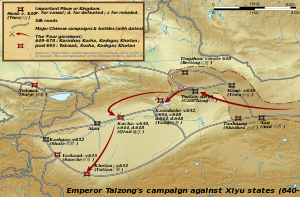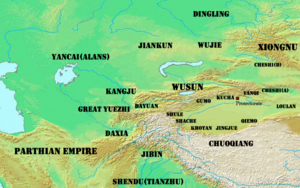المناطق الغربية
The Western Regions or Xiyu (Hsi-yu; صينية: 西域�) was a historical name specified in the Chinese chronicles between the 3rd century BC to the 8th century AD[1] that referred to the regions west of Yumen Pass, most often Central Asia or sometimes more specifically the easternmost portion of it (e.g. Altishahr or the Tarim Basin in southern Xinjiang), though it was sometimes used more generally to refer to other regions to the west of China as well, such as the Indian subcontinent (as in the novel Journey to the West).
| المناطق الغربية | |||||||||||||||||||||
|---|---|---|---|---|---|---|---|---|---|---|---|---|---|---|---|---|---|---|---|---|---|
| Chinese name | |||||||||||||||||||||
| الصينية | 西域 | ||||||||||||||||||||
| |||||||||||||||||||||
| Korean name | |||||||||||||||||||||
| هانگول | 서역 | ||||||||||||||||||||
| هانچا | 西域 | ||||||||||||||||||||
| |||||||||||||||||||||
Because of its strategic location astride the Silk Road, the Western Regions have been historically significant to China since at least the 3rd century BC. It was the site of the Han–Xiongnu War until 89 AD. In the 7th century, the Tang campaign against the Western Regions led to Chinese control of the region until the An Lushan Rebellion.

The region became significant in later centuries as a cultural conduit between East Asia, the Indian subcontinent, the Muslim world and Europe, such as during the period of the Mongol Empire. One of the most significant exports of the Western Regions was Buddhist texts, particularly the Mahayana sutras, which were carried by traders and pilgrim monks to China. The Tang dynasty monk Xuanzang crossed the region on his way to study in India, resulting in the influential Great Tang Records on the Western Regions upon his return to the Tang capital of Chang'an.
Before the onset of Turkic migrations, the peoples of the region spoke two main groups of Indo-European languages. The peoples of oasis city-states of Khotan and Kashgar spoke Saka, one of the Eastern Iranian languages, whereas the people of Kucha, Turfan and Loulan spoke the Tocharian languages.[2][3]
Xiyu tudi renwu lüe (Brief Records of the Lands and Peoples in the Western Regions), a chapter in the Gazetteer of Shaanxi compiled by Chinese scholar Ma Li in 1542, documents a route leading from the Jiayu Pass, China's northwestern outpost, to the Ottoman capital Istanbul and geography and economy of the places along the route.[4]
. . . . . . . . . . . . . . . . . . . . . . . . . . . . . . . . . . . . . . . . . . . . . . . . . . . . . . . . . . . . . . . . . . . . . . . . . . . . . . . . . . . . . . . . . . . . . . . . . . . . . . . . . . . . . . . . . . . . . . . . . . . . . . . . . . . . . . . . . . . . . . . . . . . . . . . . . . . . . . . . . . . . . . . .
See also
- Battle of Talas
- Hexi Corridor
- History of the Han dynasty
- Kingdom of Khotan
- Kingdom of Shule
- Sogdia
- Turkestan
- Protectorate of the Western Regions
- Protectorate General to Pacify the West
- Ethnic groups in Chinese history
References
Citations
- ^ Tikhvinskiĭ, Sergeĭ Leonidovich and Leonard Sergeevich Perelomov (1981). China and her neighbours, from ancient times to the Middle Ages: a collection of essays. Progress Publishers. p. 124.
- ^ Xavier Tremblay, "The Spread of Buddhism in Serindia: Buddhism Among Iranians, Tocharians and Turks before the 13th Century," in The Spread of Buddhism, eds Ann Heirman and Stephan Peter Bumbacker, Leiden & Boston: Koninklijke Brill, 2007, p. 77, ISBN 978-90-04-15830-6.
- ^ "Language Log » Tocharian C: its discovery and implications". Retrieved 2019-04-04.
- ^ Chen, Yuan Julian (2021-10-11). "Between the Islamic and Chinese Universal Empires: The Ottoman Empire, Ming Dynasty, and Global Age of Explorations". Journal of Early Modern History. 25 (5): 422–456. doi:10.1163/15700658-bja10030. ISSN 1385-3783.
Sources
- Yap, Joseph P. (2009). Wars with the Xiongnu - a translation from Zizhi Tongjian Chapters 4-17. AuthorHouse. ISBN 978-1-4490-0604-4.
- 西域考古図譜 : vol.1 西域考古図譜 : vol.2
للاستزادة
- Yap, Joseph P, (2019). The Western Regions, Xiongnu and Han, from the Shiji, Hanshu and Hou Hanshu. ISBN 978-1792829154.
